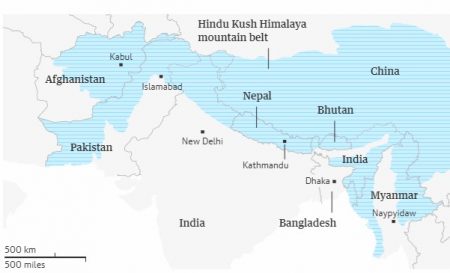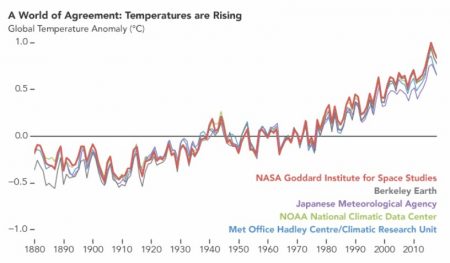February 7, 2019 – From Himalaya glaciers melting, to the finding of giant hole under an Antarctic ice sheet, to Australia’s recording of extreme heat and flooding in the eastern half of the continent, and to the latest report from NASA and NOAA on global surface temperatures, this has been quite the week for climate change revelations.
Himalaya Glaciers are Melting
The just published Hindu Kush Himalaya Assessment report reveals that the planet’s third pole, the glaciers of the Himalaya Mountain chain is melting rapidly with predictions that two-thirds of the ice volume may be gone by 2100. The Hindu Kush is a primary water source for the rivers that flow into India, Pakistan, China, Bangladesh, and the nations of Southeast Asia, home to 2 billion people. The report represents the cumulative work of 200 scientists and was subjected to peer review from 125 outside experts. Even if the global mean temperature rise were to be contained at no greater than 1.5 Celsius (2.7 Fahrenheit) the research indicates that a third of the ice would be gone. At a 2.0 Celsius (3.6 Fahrenheit) rise, half would disappear.
The Hindu Kush is a range of mountains 3,500 kilometers in length. Over that distance some of the glaciers remain stable, and some are even increasing in volume. But the largest number are melting leading to increased river water volume. This is expected to continue through the mid-century before volumes decline wtih the Indus and Central Asian rivers most impacted.

Antarctica is Melting
Following fast upon the latest reports about Antarctica melting six times faster than four decades ago, comes the revelation that an enormous cavity has formed under the Thwaites Glacier which is currently pouring 50 billion tons of ice into the Southern Ocean annually. The contribution of this glacier alone is contributing to 4% of global sea level rise. But the discovery of the cavity, over 300 meters in height, and 10 kilometers in length, represents 14 billion tons of missing ice. The findings appear in the January 30, 2019 edition of Science Advances.
As for the story about the faster melting of continental ice from Antarctica, the report appearing in the January 14, 2019 edition of the journal PNAS is troubling because it shows ice loss has accelerated by a factor of over six since 1980. The volume represents 252 billion tons and is contributing to sea level rise of 1.3 centimeters (0.5 inches) over the period studied.

Australia is Simmering
The Southern Hemisphere is into summer and Australia, already hot, is seeing new record temperatures across the continent. In Adelaide last week the thermometer rose to 46.7 Celsius (116 Fahrenheit). January has turned out to be the hottest month in the country’s history with the mean temperature exceeding 30 Celsius (86 Fahrenheit). This follows the warmest December on record with every state and territory in the country under a heatwave.
In a special climate statement issued on January 24th, the country’s weather service described conditions affecting areas from the tropical coasts of Queensland to Western Australia. Rainfall was reported as only 20% of average. Bushfires broke out in Tasmania under the heat and tinder-dry conditions. In New South Wales one community reported four consecutive days of temperatures above 47 Celsius (117 Fahrenheit). In the Murray-Darling basin, Australia’s largest river system, scientists reported hundreds of thousands of native fish dying from rising river temperatures leading to algae blooms and the deoxygenation of the water.
Meanwhile, at the northeastern corner of the continent, abnormal monsoonal type rain has created devastating floods. Nearly 120 centimeters (4 feet) fell in seven days accompanied by 90 kilometer (50 mile) per hour winds. In one day 25 centimeters (close to one foot) fell.
If any country and continent is the canary in the cage for climate change, it is Australia.

NASA and NOAA Report 2018 the Fourth Warmest Year on Record
Stated Goddard Institute for Space Studies (GISS) Director Gavin Schmidt, “2018 is yet again an extremely warm year on top of a long-term global warming trend.” Temperatures last year were 0.83 Celsius (1.5 Fahrenheit) degrees warmer than the mean registered between 1951 and 1980. And 2018 turned out to be the fourth warmest year on record just behind 2016, 17, and 15. NASA reported that the past five years represent collectively, the warmest years ever recorded.
NASA gathered the temperature data from 6,300 weather stations, ship and buoy sea surface temperature observations and measurements from Antarctica. NOAA issued findings just slightly lower than those of NASA (a rise of 0.79 Celsius or 1.42 Fahrenheit) above the 20th-century average. GISS is within the Earth Sciences Divison of NASA with laboratories in Greenbelt, Maryland, and Columbia University in New York City.
















